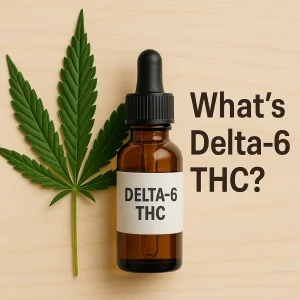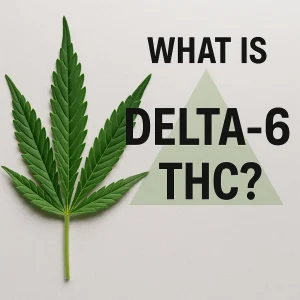What Is Delta-6 THC?
What Is Delta-6 THC?
Delta-6 THC is a rare THC isomer that shows up in tiny amounts in cannabis. Most people never encounter it on a label because labs group minor isomers under “other cannabinoids.” You see delta-9 THC on flower, sometimes delta-8 or delta-10 in vape products, but delta-6 sits in the background with very little published data. This guide explains what it is, how it compares with the THC you already know, what extraction methods produce it, and what a Canadian shopper should keep in mind before buying anything that mentions delta-6.
If you want reliable jars while you read, check our live shop. For quick answers on shipping and payment, see the FAQ. When you need help building a cart, head to contact.

What is Delta-6 THC and why you rarely see it on labels
The short version
-
Delta-6 THC is a structural isomer of tetrahydrocannabinol.
-
It occurs naturally in trace amounts. Most commercial delta-6 comes from conversion processes in a lab.
-
Peer-reviewed research on effects is limited. Expect less published evidence than for delta-9 or CBD.
-
Canadian buyers should focus on regulated products with full panels rather than hype around minor isomers.
THC isomers in plain language
THC molecules share the same atoms but connect them in slightly different ways. That small shift moves the double bond along the carbon ring. The position of that bond creates different isomers:
-
Delta-9 THC: primary psychoactive compound in cannabis flower.
-
Delta-8 THC: present in small amounts in the plant, often produced via conversion from CBD.
-
Delta-10 THC: trace in nature, commonly a conversion by-product.
-
Delta-6 THC: even rarer, usually a by-product when manufacturers convert other cannabinoids.
Those positions matter because they change how the molecule interacts with CB1 and CB2 receptors. Small changes can alter onset, intensity, and duration.
Where delta-6 THC comes from
You will not see meaningful delta-6 levels in standard flower. Two routes create it:
-
Incidental formation during conversions
When a lab converts CBD or delta-9 under heat and acid catalysts, side reactions can form multiple isomers. Delta-6 shows up in that mix at low levels. -
Targeted synthesis with cleanup
Skilled processors can steer reactions to favor certain isomers, then purify the result with chromatography. Even then, yields for delta-6 tend to be modest and cleanup drives cost.
Because of that, most consumer products that mention delta-6 list it as a trace component rather than the star ingredient.
What does delta-6 THC feel like
There is no large clinical data set that maps dose to effect. Vendor claims often blur lines between isomers. Based on limited reports and the general behavior of double-bond shift isomers:
-
Expect psychoactivity if dose is high enough, since related isomers interact with CB1.
-
Onset could feel lighter or shorter than delta-9.
-
Terpenes and other cannabinoids in the product shape the experience more than the tiny amount of delta-6 itself.
If you want steady, predictable sessions, stick with strains and products that list delta-9 THC and full terp profiles. For example, daytime clarity from Sour Diesel Small AAA or an evening wind-down like Premium Pink Kush Indica.
Why you rarely see “delta-6” on labels
Three practical reasons:
-
Trace levels: Natural cannabis does not produce much delta-6.
-
Testing focus: Standard panels quantify delta-9, delta-8, and CBD with high confidence. Minor isomers often go into an “other THC isomers” bucket.
-
Regulatory simplicity: Canadian labels emphasize total THC and CBD for clarity.
If a product markets delta-6 as a headline feature, ask for a recent certificate of analysis that lists individual isomers.
Safety and quality signals to check
Focus on basics that always matter more than a novelty isomer:
-
Full lab panel: Potency, residual solvents, heavy metals, pesticides, and terpene profile.
-
Clear ingredients: Especially for vapes. Look for cannabis-derived terpenes and clean carrier choices.
-
Supplier transparency: Batch numbers and test dates should be easy to find.
Health Canada’s consumer page is a solid baseline on legal cannabis and product safety in Canada. It explains rules, age limits, and general guidance for buyers. Read it here: https://www.canada.ca/en/health-canada/services/drugs-medication/cannabis.html
Delta-6 vs delta-8 vs delta-9
Availability
-
Delta-9 dominates in flower and regulated extracts.
-
Delta-8 shows up in some conversion-based products.
-
Delta-6 sits at the margin due to low yields and limited demand.
Data
-
Delta-9 has the strongest evidence base.
-
Delta-8 has growing but mixed literature.
-
Delta-6 has sparse public data.
Use case
-
Choose delta-9 flower or rosin for predictable results and flavor.
-
Treat delta-8 or delta-6 claims as niche extras rather than the main reason to buy.
How processors end up with delta-6
A quick look at the chemistry helps you evaluate marketing:
-
Converting CBD to THC under acidic conditions yields mixtures of isomers. Temperature, acid strength, and time change the ratios.
-
Reaction mixtures then go through distillation and chromatography to isolate target fractions.
-
Minor isomers, including delta-6, show up when reactions overrun or when cleanup is partial.
This is why trustworthy brands publish third-party lab data rather than surface-level claims. Numbers beat adjectives.

Cannabis leaf on a gray backdrop with a green triangle and the headline “What is Delta-6 THC?”
What Canadian shoppers should do
Stick with regulated vendors and clear strain pages. If you want value while you explore flavor lanes, start with smalls and variety packs before chasing niche isomers:
-
Everyday sativa value: Sour Diesel Small AAA
-
Evening comfort: Premium Pink Kush Indica
-
Gassy weekend pick: Purple Jet Fuel
-
Sampler for learning: Quarter LB Premium Smalls Variety Pack or LB Premium Smalls Variety Pack
FAQs
Is delta-6 THC naturally occurring
Yes, in trace amounts. Most detectable delta-6 in finished products comes from conversion processes.
Is delta-6 legal in Canada
Canadian rules regulate THC broadly in legal channels. Focus on licensed products with full testing rather than loopholes around isomer names.
Will delta-6 show up on a drug test
Standard tests look for THC metabolites, not the exact isomer. Plan as if any THC isomer counts.
Does delta-6 feel weaker than delta-9
Evidence is limited. Many users report effects that feel lighter or shorter, but product formulation and dose drive most of the difference.
Should I buy products marketed around delta-6
Buy for the full product spec, not a single line on the label. Look for clean extraction, clear terpene info, and recent third-party tests.
Bottom line
Delta-6 THC is a minor isomer with limited public data and scarce natural abundance. It shows up mainly as a trace by-product in conversion-based extracts. If you want reliable flavor and a consistent feel, choose well-described flower and proven concentrates with strong lab documents. Keep your focus on total THC, terpene profile, and brand transparency. When you are ready to explore, start with balanced staples in the shop and build outward from there.

